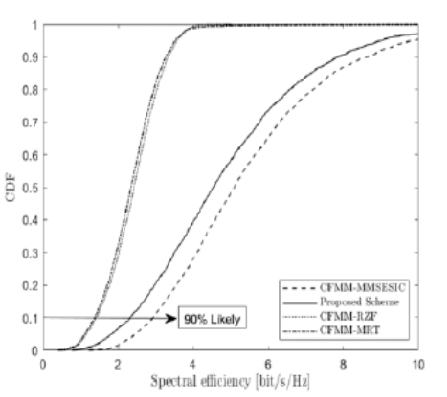


Indian Journal of Science and Technology
DOI: 10.17485/IJST/v17i13.2959
Year: 2024, Volume: 17, Issue: 13, Pages: 1292-1303
Original Article
Swapnaja Deshpande1, Mona Aggarwal1*, Pooja Sabherwal1, Swaran Ahuja1
1MDE Deptt, The NorthCap University, 122017, Gurgaon, India
*Corresponding Author
Email: [email protected]
Received Date:21 November 2023, Accepted Date:18 January 2024, Published Date:22 March 2024
Objectives: With increase in number of access points in Cell-Free Massive Multiple Input Multiple Output (CFMM) system, spatial complexity of calculating precoding vector increases with traditional precoding schemes. So, to reduce computational complexity, network cost, and run time, a new deep learning -aided precoder is specially designed for CFMM system. The performance of downlink (DL) Cell-Free Massive Multiple Input Multiple Output (CFMM) system operating under Rayleigh fading channel model is analyze using new deep learning-based precoding scheme. Methods: We introduce new deep learning-aided precoder and an improved version of basic scalable pilot assignment algorithm which enhances system performance. We derive closed- form expression for average DL spectral efficiency (SE) for the proposed scheme, which is then compared with Minimum Mean Square Error Successive Interference Cancellation (MMSESIC), Regularized Zero Forcing (RZF), Least Square (LS) and Maximum Ratio (MR) combining techniques. We analyze the proposed scheme with perfect channel state information (CSI), instantaneous CSI, coherent transmission, non-coherent transmission, different pilot configuration. Findings: The spectral efficiency obtained with CFMM-MMSESIC and the proposed scheme is 3 bits/s/Hz, and 2.5bits/s/Hz respectively, which clearly indicates the difference of 20 % only. So, the proposed scheme gives near optimal results, and we can use simple linear combining techniques instead of complex non-linear combining techniques. Also, the proposed scheme with coherent data transmission gives performance curve, which is very close to MMSESIC scheme as desired. The performance of the proposed system is improved by reducing run time and computational complexity as compared to conventional linear precoding schemes. Novelty: The proposed precoder improves performance by reducing run time and computational complexity. Advanced pilot assignment algorithm enhances performance by reducing pilot contamination.
Keywords: Cell-Free Massive Multiple Input Multiple Output, Pilot Contamination, Precoding, Minimum Mean Square Error Successive Interference Cancellation, Maximum Ratio, Regularized Zero Forcing (RZF), Least Square (LS)
© 2024 Deshpande et al. This is an open-access article distributed under the terms of the Creative Commons Attribution License, which permits unrestricted use, distribution, and reproduction in any medium, provided the original author and source are credited. Published By Indian Society for Education and Environment (iSee)
Subscribe now for latest articles and news.